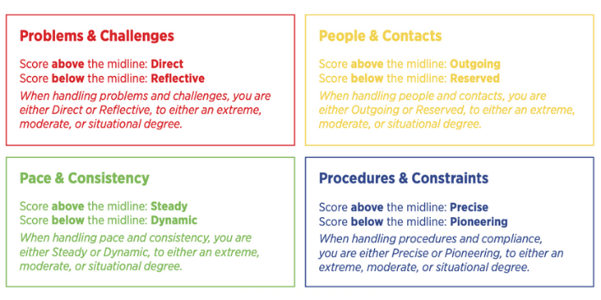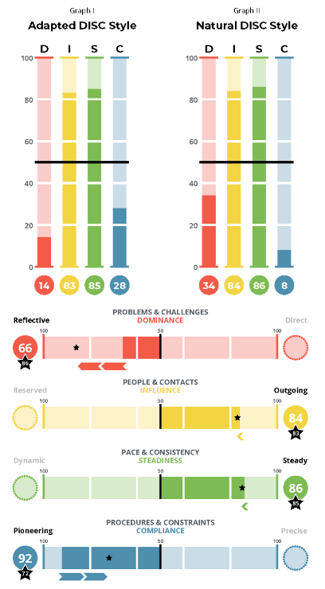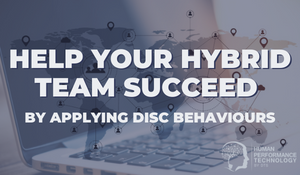The New Way to Look at the DISC Graph
A less sophisticated DISC practitioner may be overly focused on the high points on a DISC graph. Perhaps this is an easy mistake to make when the graph is vertical and naturally insinuates that there are high features and low features of each factor. The fact of the matter is that people are made up of more than what’s high in their DISC graph.
We’ve helped our clients to learn, understand and apply all the features (high and low) of each of the four DISC factors. It’s important to remember that the low factors are just as indicative of a person as the high factors. We all have characteristics from each of the four factors.
As a reminder, DISC is an acronym for: Dominance, Influence, Steadiness and Compliance. DISC is a behavioural model and assessment tool that helps us understand some of the ways we respond to problems and challenges (D), people and contacts (I), pace and consistency (S), and procedures and constraints (C).
These two-word combinations are referred to as “P and C” words. We teach the significance of the “P and C” words in our DISC accreditation. They represent two words that are a simple way to explain each of the behaviours and what they explore.
What’s NEW
Our assessments partner, TTI Success Insights, is leading the industry with a new way to look at the DISC graph. The TTI Success Insights team is removing the concept of “high” and “low” in an effort to help bring a more sophisticated understanding of one’s DISC graph.
They are repositioning the DISC graph as a continuum, which is what was intended in the original assessment created by Walter V. Clarke. This means transitioning from a vertical graph to a horizontal continuum, so that DISC practitioners can use neutral vocabulary to discuss a profile.
This important article covers these sections:
- Introducing the New DISC Behavioural Continuum
- How to Read the New DISC Behavioural Continuum
- Reading a Sample DISC Behavioural Continuum
- New DISC Vocabulary
- How to Get Access to the New DISC Behavioural Continuum
Introducing the New DISC Behavioural Continuum
The horizontal behavioural continuum is a new view of the DISC graph. The most exciting part of this new continuum is the elimination of high and low scores. Instead of an individual being a “low D”, for example, you now have the language and tools to explain that they are especially reflective when it comes to responding to Problems and Challenges.

While the traditional vertical graph requires two graphs for Natural and Adapted scores, the new DISC continuum combines both scores, plus new descriptors for increased understanding, as well as “P and C” words to help describe the continuum.
How to Read the New DISC Behavioural Continuum
Using the key pictured below, the following seven points highlight the various components of the DISC behavioural continuum.

1. Natural Score: An individual’s natural behaviour or how they prefer to do what they do.
This is represented by a score in a circle at the end of the continuum. One side of each continuum is solid with a Natural score. This is your behavioural style for those keywords at the end of each continuum. The other side of each continuum is faded without a score.
2. Adapted Score: How an individual adapts their behaviour to fit the situation they are in.
This is represented by a score in a star at the end of the continuum. The small black star is on the actual plot point of the Adapted Score.
3. Chevron: Symbol used to indicate how an individual is shifting from their Natural score to their Adapted score.
- These show the intensity and direction of the adaptation.
- Each full chevron represents 10 points on the continuum. There can be partial chevrons. For example with a score of 25, there would be two and a half chevrons.
4. Keywords: The “P and C” words to help classify each continuum.
The descriptors on either end of the continuum relate directly with keywords or “P and C” words. For example, Olivia is pioneering (descriptor) when dealing with procedures and constraints (“P and C” words for this DISC factor).
5. Midline (Energy Line): The middle of the continuum at 50.
- The right side of the midline is everything above 50 on the traditional DISC graph.
- The left side of the midline is everything below 50 on the traditional DISC graph.
- The natural score indicated by the filled in segments of the continuum always starts at 50 and fills out to the score.
6. Segments: The continuum is divided into 5 segments.
Each segment represents 20 points out of the 100 point scale. See the following section on Vocabulary for more information on each of the segments.
7. Legend: Located at the bottom right corner below the continuum.
The legend shows:
- Norm info: The year the tool was normed and the questionnaire used to produce the graph.
- Date: The day, month and year the assessment was completed.
- Time: How much time (in minutes) it took to complete the assessment.
Reading a Sample DISC Behavioural Continuum
Let's look at Olivia's traditional DISC graph versus her new DISC behavioural continuum. How would we debrief Olivia using her profile?
 Olivia is more Reflective than Direct when it comes to problems and challenges. The circle with 66 means that her Natural score is 66 on the Reflective side of the continuum. The star on the continuum represents her Adapted score, which is 86. This means that Olivia is adapting 20 points from her Natural style. She becomes even more Reflective in this situation.
Olivia is more Reflective than Direct when it comes to problems and challenges. The circle with 66 means that her Natural score is 66 on the Reflective side of the continuum. The star on the continuum represents her Adapted score, which is 86. This means that Olivia is adapting 20 points from her Natural style. She becomes even more Reflective in this situation.
This shift is indicated by the chevrons below the graph. These arrow-like symbols indicate movement. Each chevron represents 10 points on the continuum, so quickly you are able to tell that Olivia is adapting 20 points, since there are 2 full chevrons.
It’s important to remember that the horizontal continuum eliminates the use of the “high and low” language that was used with the traditional vertical graph. Looking above, Olivia might have previously been considered a "high S" (86 out of 100), but her primary behavioural style is actually her "low C" (8 out of 100). Even though this score is clearly farthest from the midline, since it’s an 8 or the “lowest” bar in the traditional graph, many overlook it in favour of the "highest" bar.
The horizontal behavioural continuum eliminates any confusion. While the traditional vertical graph would label Olivia as a “low C” at 8 out of 100, the new DISC behavioural continuum shows that she is more Pioneering than Precise when responding to procedures and constraints.
The scores from the traditional DISC graph are converted in the following way. Scores above 50 are the same and on the right side of the midline. Scores below 50 are subtracted from 100 and shown on the left side of the midline. All Natural scores start from the midline or 50 and fill outward. Therefore, Olivia’s score of 8 is subtracted from 100 to get her primary style at 92. The Adapted score is converted the same way, however the chevrons start at the natural score and show the intensity and direction of the adaptation.
New DISC Vocabulary
Here are a few examples of how you can clearly communicate the meaning behind behaviours. Remember to eliminate your use of “high” and “low” to explain behaviour by referring to the segments which represent extreme, moderate and situational behaviour. Look at the same example continuum.
Example: Olivia is very Pioneering when it comes to procedures, especially Steady in her pace, and highly Outgoing with the people she meets. She is somewhat Reflective when facing a problem or challenge.
How did we form that example? Looking at Olivia’s continuum, she is moderately Reflective, extremely Outgoing, extremely Steady, and extremely Pioneering. Her Reflective score is slightly past situational into moderate, while her Outgoing and Steady scores are slightly past moderate into extreme.
Here are a few ways to communicate situational, moderate and extreme results.

How to Get Access to the New DISC Behavioural Continuum
Thanks to our partner TTI Success Insights Australia and New Zealand, our clients (and other profile suppliers in this region) can access the new DISC Behavioural Continuum in the Engagement Report.

Given the rise of the hybrid work environment and the acknowledgement of the great resignation, TTI Success Insights developed this concise and intuitive report that helps individuals understand their behaviour and motivations. It’s the new tool your team needs to thrive, right now.
View a sample Engagement Report here and contact us at hello@dtssydney.com with any questions.
What do you think of the new DISC behavioural continuum?

Temre Green, PhD
Head of Consulting Services, Australia & New Zealand. Temre has designed, planned and delivered business strategy and transformation programs that were driven by a range of factors, such as innovation, growth, compliance, regulations, restructures and economic downturns. As an Industrial-Organisational Psychologist, Temre has spent her career dedicated to organisational behaviour and the work environment. She is currently focused on the future of work and multiple areas of organisational development that support organisational growth and health.


/the%20worlds%20number%201%20behavioural%20assessment.png?width=374&name=the%20worlds%20number%201%20behavioural%20assessment.png)
We Would Like to Hear From You (0 Comments)